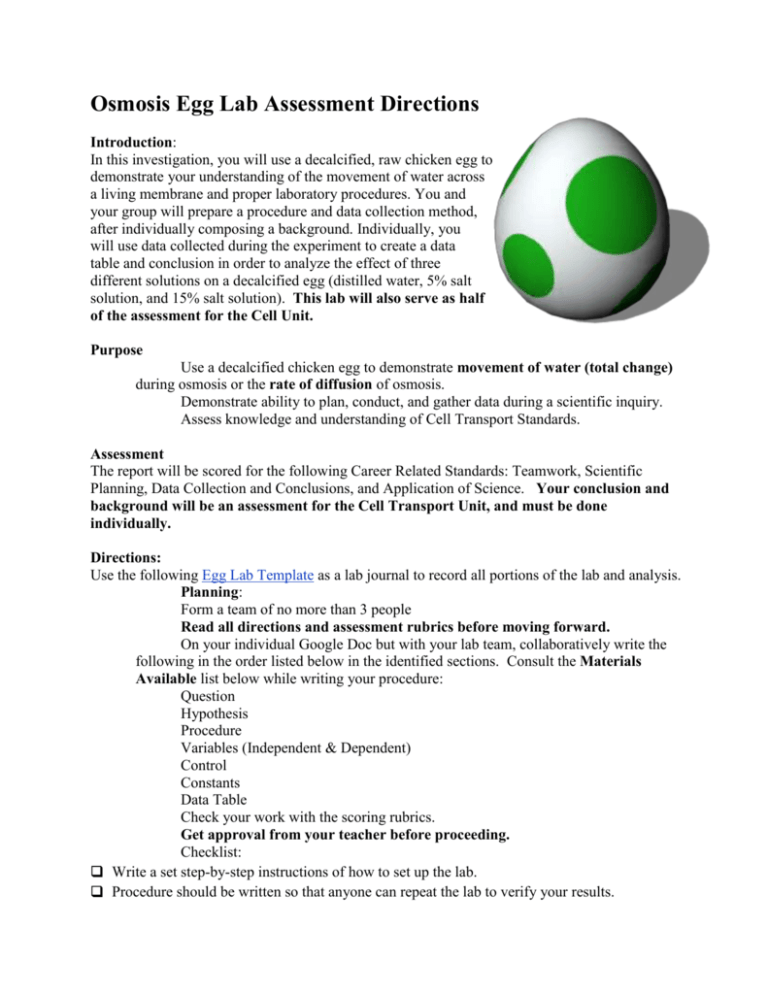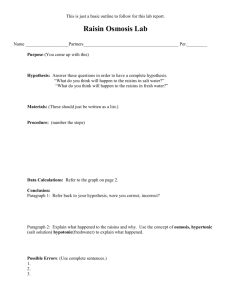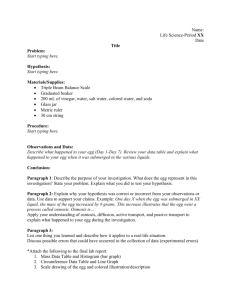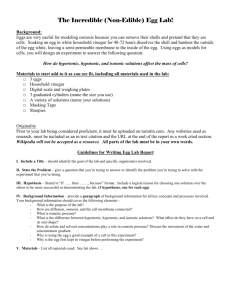Osmosis Egg Lab
advertisement

Osmosis Egg Lab Assessment Directions Introduction: In this investigation, you will use a decalcified, raw chicken egg to demonstrate your understanding of the movement of water across a living membrane and proper laboratory procedures. You and your group will prepare a procedure and data collection method, after individually composing a background. Individually, you will use data collected during the experiment to create a data table and conclusion in order to analyze the effect of three different solutions on a decalcified egg (distilled water, 5% salt solution, and 15% salt solution). This lab will also serve as half of the assessment for the Cell Unit. Purpose Use a decalcified chicken egg to demonstrate movement of water (total change) during osmosis or the rate of diffusion of osmosis. Demonstrate ability to plan, conduct, and gather data during a scientific inquiry. Assess knowledge and understanding of Cell Transport Standards. Assessment The report will be scored for the following Career Related Standards: Teamwork, Scientific Planning, Data Collection and Conclusions, and Application of Science. Your conclusion and background will be an assessment for the Cell Transport Unit, and must be done individually. Directions: Use the following Egg Lab Template as a lab journal to record all portions of the lab and analysis. Planning: Form a team of no more than 3 people Read all directions and assessment rubrics before moving forward. On your individual Google Doc but with your lab team, collaboratively write the following in the order listed below in the identified sections. Consult the Materials Available list below while writing your procedure: Question Hypothesis Procedure Variables (Independent & Dependent) Control Constants Data Table Check your work with the scoring rubrics. Get approval from your teacher before proceeding. Checklist: ❑ Write a set step-by-step instructions of how to set up the lab. ❑ Procedure should be written so that anyone can repeat the lab to verify your results. ❑ ❑ ❑ ❑ ❑ The procedure should be logical, safe, well organized and practical. The procedure should provide enough data to answer the question. Describe which variables you will keep constant. Identify the independent variable (the manipulated variable). Identify the dependent variable (what you measured). Background: Individually write a background introducing the lab. Suggestions of what to include in your background can be found here Do not copy and paste. A works cited must be included. Create a works cited section by using EasyBib. A copy paste of a url link is not acceptable. Your background can be written, below, while allowing the egg to sit in the solutions. Checklist: ❑ Write enough relevant, factual background information to support or explain your prediction of what the result of the lab will be. Should be at least two or more paragraphs. ❑ Identify the direction particles, like salt and water, will move depending on the concentration gradient. ❑ Indicate the direction water will diffuse across a membrane when a cell is in hypotonic, hypertonic, and isotonic solution. ❑ Evaluate how facilitated diffusion is similar to both passive transport and active transport. Write a question & hypothesis: Checklist: ❑ Write a testable question that can be answered by the data gathered in the lab. ❑ Write a testable hypothesis. ❑ ❑ ❑ ❑ ❑ ❑ ❑ Collect Data by following your procedure. Checklist: Collect reasonable data for the question that was asked. Include both a data table and a graph Data tables and graphs should be titled, labeled, organized and logical. Use appropriate measurements and units. The graph should demonstrate patterns and make it easy to observe patterns and conclusions. Include both qualitative and quantitative data. Use data to explain and answer the experiment hypothesis/question. Analyze data and write a conclusion. Checklist: ❑ Restates hypothesis ❑ ❑ ❑ ❑ ❑ ❑ ❑ ❑ ❑ Answers your question & hypothesis Use data (qualitative & quantitative) to answer questions/hypothesis Explain why results occurred Identify the direction water moved depending on the concentration gradient of the solution Identify each solution from the experiment as hypertonic, hypotonic, isotonic based off your collected data Explain how this lab is an example of passive transport Evaluate similarities between observed results and facilitated diffusion Discuss errors (both procedure & human) Discuss modifications to improve lab Analysis Directions: You will have up to one class period to analyze your data and write your conclusion. Writing should be your own work. Complete the following for your analysis: Create a graph for your data (make sure it is labeled and has a correct title) Insert your graph into your google document. Write a conclusion that includes all of the checklist items. Consult all scoring rubrics to check that your lab is complete. Materials Available: One decalcified eggs per group Distilled water, 5% salt water, 15% salt water (you will use 150 mL of each solution) Up to three 250mL beakers per group Masking tape Spoon Sharpies Weighing boats Balance Egg Information Resources: Nutritional Information: Egg Nutrition Center Department of Agriculture Egg Facts Vocabulary to Use throughout your egg lab write-up: Osmosis Isotonic Hypertonic Cell Membrane Hypotonic Semi-Permeable Membrane Dynamic Equilibrium Concentration Solute Diffusion





